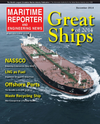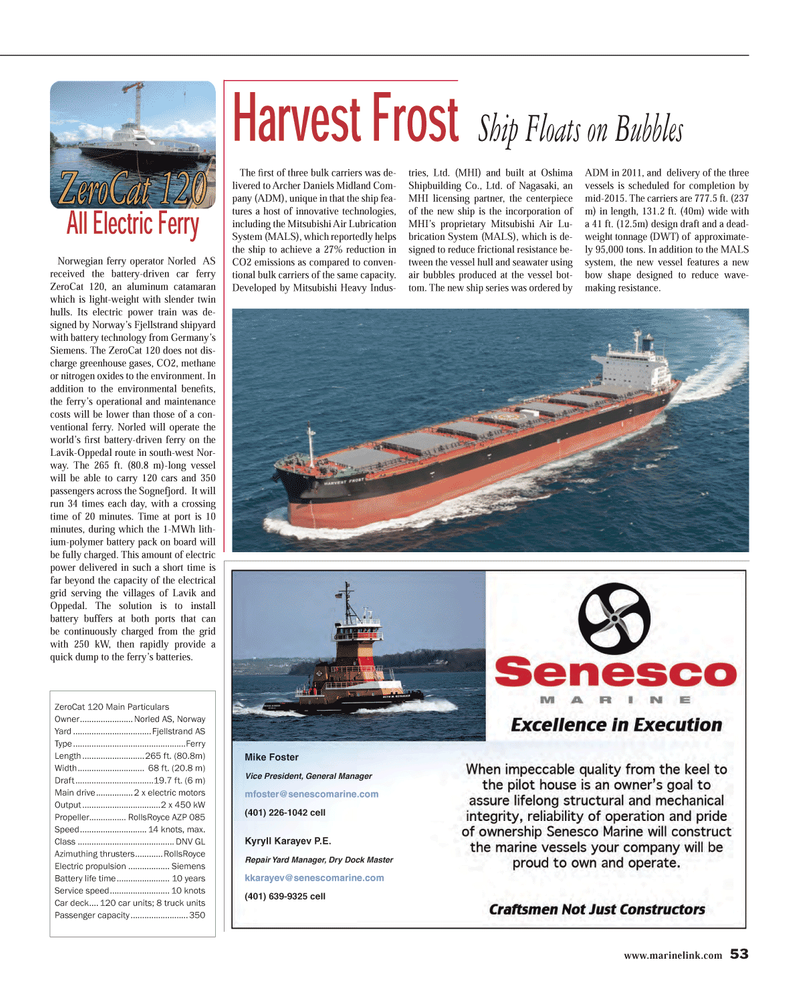
Page 53: of Maritime Reporter Magazine (December 2014)
Great Ships of 2014
Read this page in Pdf, Flash or Html5 edition of December 2014 Maritime Reporter Magazine
www.marinelink.com 53
The fi rst of three bulk carriers was de- livered to Archer Daniels Midland Com- pany (ADM), unique in that the ship fea- tures a host of innovative technologies, including the Mitsubishi Air Lubrication
System (MALS), which reportedly helps the ship to achieve a 27% reduction in
CO2 emissions as compared to conven- tional bulk carriers of the same capacity.
Developed by Mitsubishi Heavy Indus- tries, Ltd. (MHI) and built at Oshima
Shipbuilding Co., Ltd. of Nagasaki, an
MHI licensing partner, the centerpiece of the new ship is the incorporation of
MHI’s proprietary Mitsubishi Air Lu- brication System (MALS), which is de- signed to reduce frictional resistance be- tween the vessel hull and seawater using air bubbles produced at the vessel bot- tom. The new ship series was ordered by
ADM in 2011, and delivery of the three vessels is scheduled for completion by mid-2015. The carriers are 777.5 ft. (237 m) in length, 131.2 ft. (40m) wide with a 41 ft. (12.5m) design draft and a dead- weight tonnage (DWT) of approximate- ly 95,000 tons. In addition to the MALS system, the new vessel features a new bow shape designed to reduce wave- making resistance.
Mike Foster
Vice President, General Manager [email protected] (401) 226-1042 cell
Kyryll Karayev P.E.
Repair Yard Manager, Dry Dock Master [email protected] (401) 639-9325 cell
Senesco MR Jan14.indd 1 11/19/2013 11:59:46 AM
Harvest Frost Ship Floats on Bubbles
Norwegian ferry operator Norled AS received the battery-driven car ferry
ZeroCat 120, an aluminum catamaran which is light-weight with slender twin hulls. Its electric power train was de- signed by Norway’s Fjellstrand shipyard with battery technology from Germany’s
Siemens. The ZeroCat 120 does not dis- charge greenhouse gases, CO2, methane or nitrogen oxides to the environment. In addition to the environmental benefi ts, the ferry’s operational and maintenance costs will be lower than those of a con- ventional ferry. Norled will operate the world’s fi rst battery-driven ferry on the
Lavik-Oppedal route in south-west Nor- way. The 265 ft. (80.8 m)-long vessel will be able to carry 120 cars and 350 passengers across the Sognefjord. It will run 34 times each day, with a crossing time of 20 minutes. Time at port is 10 minutes, during which the 1-MWh lith- ium-polymer battery pack on board will be fully charged. This amount of electric power delivered in such a short time is far beyond the capacity of the electrical grid serving the villages of Lavik and
Oppedal. The solution is to install battery buffers at both ports that can be continuously charged from the grid with 250 kW, then rapidly provide a quick dump to the ferry’s batteries.
ZeroCat 120 Main Particulars
Owner ....................... Norled AS, Norway
Yard ..................................Fjellstrand AS
Type .................................................Ferry
Length ...........................265 ft. (80.8m)
Width ............................. 68 ft. (20.8 m)
Draft ..................................19.7 ft. (6 m)
Main drive ................2 x electric motors
Output ..................................2 x 450 kW
Propeller................ RollsRoyce AZP 085
Speed ............................. 14 knots, max.
Class .......................................... DNV GL
Azimuthing thrusters ............RollsRoyce
Electric propulsion .................. Siemens
Battery life time ....................... 10 years
Service speed .......................... 10 knots
Car deck .... 120 car units; 8 truck units
Passenger capacity ......................... 350
ZeroCat 120
All Electric Ferry
MR #12 (50-57).indd 53 12/4/2014 10:14:53 AM

 52
52

 54
54
